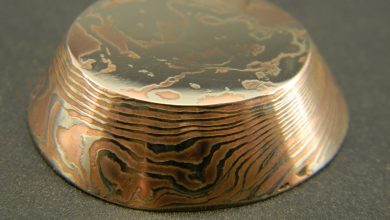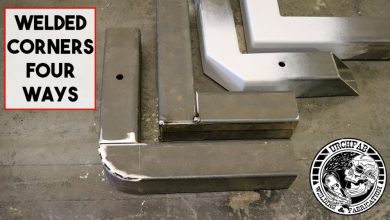Why Is Arc Length Important in Welding
Arc length is important in welding because it directly affects the voltage in the welding circuit, which in turn affects the current flow and heat generated.
A long arc length reduces current flow and heat, resulting in weak welds with incomplete fusion.
On the other hand, a short arc length increases current flow and heat input, which can cause overheating and burn-through of thin materials.
Moreover, arc length influences the depth of penetration into the base metal, with a long arc resulting in shallower penetration and a short arc resulting in deeper penetration.
Additionally, arc length plays a crucial role in the appearance and quality of the weld.
A longer arc length produces a narrow and inconsistent weld bead with spatter and a rough surface finish, while a shorter arc length produces a wider, flatter, and more uniform weld bead that is visually appealing.
Therefore, controlling and optimizing arc length is necessary to achieve strong, reliable, and visually appealing welds.
Advancements in welding technology further allow for greater control over arc length, making it essential for welding professionals to stay informed about these developments to remain competitive.
By understanding the role of arc length, welders can become more skilled and successful in their craft.
Did You Know?
1. In welding, the arc length refers to the distance between the electrode and the workpiece. One interesting trivia is that maintaining the correct arc length is crucial for achieving a high-quality weld. A too short arc length can cause the electrode to stick to the workpiece, while a too long arc length can result in a weak and porous weld.
2. Did you know that the temperature of the arc in welding can reach up to 20,000 degrees Celsius (36,032 degrees Fahrenheit)? This extreme heat is necessary for melting and fusing metals together, making welding a truly fascinating and powerful process.
3. While welding is commonly associated with metals, it can also be used to join other materials such as plastics, ceramics, and even certain types of glass. This versatility highlights the importance of arc length in welding, as different materials require specific arc lengths to achieve successful results.
4. Arc length is not only important for the quality of a weld, but it also has implications for the safety of the welder. When welding, the arc emits intense ultraviolet (UV) radiation, which can cause harmful burns to the skin and eyes. Properly controlling the arc length helps minimize the risk of UV exposure and ensures the welder’s safety.
5. The concept of arc length is not limited to welding; it also has applications in other fields such as mathematics and physics. In mathematics, arc length refers to the length of a curve in a coordinate plane, while in physics, it relates to the distance between two points along a curved path. The importance of arc length extends beyond welding and showcases its significance in various aspects of life.
The Significance Of Arc Length In Welding
Arc length is crucial in welding as it determines the distance between the welding electrode and the workpiece. While it may seem like a minor detail, the arc length has significant implications on the quality of the weld. It affects several key aspects, such as voltage, current flow, penetration, fusion, and the appearance of the weld bead.
Improving the arc length can lead to:
- Enhanced welding control
- Improved weld bead appearance
- Increased penetration and fusion
- Better overall weld quality
Remember, maintaining an optimal arc length is vital for successful welding.
“The arc length is a critical factor in welding that impacts various aspects of the welding process.”
Impact Of Arc Length On Welding Voltage And Current Flow
The arc length directly affects the voltage in the welding circuit. A longer arc length leads to higher voltage, while a shorter arc length results in lower voltage. This is because the voltage drops as the current travels through the long arc length.
In terms of current flow, a long arc length reduces the flow of current and heat generated. Conversely, a short arc length increases the current flow and heat input. Therefore, understanding and controlling the arc length is essential for maintaining the desired voltage and current flow, which ultimately impacts the weld quality.
Penetration And Fusion: Effects Of Long And Short Arc Lengths
Arc length plays a significant role in determining the depth of penetration into the base metal. A long arc length results in shallower penetration, while a short arc length leads to deeper penetration. This is because a longer arc requires more time for the heat to reach the base metal, resulting in less heat input into the material.
The fusion between the base metal and the filler material is also affected by arc length. A long arc length can result in weak welds with incomplete fusion, while a short arc length may cause overheating and burn-through of thin materials. Achieving the right balance in arc length is crucial to ensure proper fusion and strong, reliable welds.
Visual And Structural Impact Of Arc Length On Weld Beads
The arc length plays a crucial role in the appearance and structural quality of the weld bead.
- A long arc length can lead to a narrow, inconsistent weld bead with spatter and a rough surface finish.
- Conversely, a shorter arc length produces a wider, flatter, and more uniform weld bead, resulting in a visually appealing outcome.
Furthermore, the arc length also influences the welding speed, as shorter arcs allow for faster welding.
From a structural standpoint, the arc length is a critical factor in determining the quality of the weld bead.
- A shorter arc length provides better control and manipulation of the molten metal, facilitating improved fusion between the base metals.
- Ultimately, this results in stronger and more reliable welds.
It’s important to consider that these effects on the weld bead are highly dependent on the type and thickness of the materials being welded.
Controlling And Optimizing Arc Length For Strong And Visually Appealing Welds
Controlling and optimizing the arc length is crucial for achieving the desired appearance, quality, and speed of the welding process. Arc length can be adjusted by changing the distance between the electrode and the base metal or by changing welding parameters such as voltage and current.
In MIG/MAG welding, arc length is primarily controlled by adjusting the voltage. In TIG welding, manual manipulation of the torch or pedal is used to control the arc length. In MMA welding, arc length is controlled mainly by manual manipulation of the electrode holder or rod angle.
Advancements in welding technology have allowed for greater control over arc length and other welding parameters. Staying informed about these developments is important for welding professionals to remain competitive in the industry.
Megmeet Welding Technology offers the latest welding technology and expertise to achieve the best possible welds.
Understanding the role of arc length is a fundamental step in becoming a skilled and successful welder. By learning how to control and optimize the arc length, welders can produce strong, reliable, and visually appealing welds that meet the required quality standards.
- Controlling and optimizing the arc length is crucial for achieving the desired appearance, quality, and speed of the welding process.
- Arc length can be adjusted by changing the distance between the electrode and the base metal or by changing welding parameters such as voltage and current.
- In MIG/MAG welding, arc length is primarily controlled by adjusting the voltage.
- In TIG welding, manual manipulation of the torch or pedal is used to control the arc length.
- In MMA welding, arc length is controlled mainly by manual manipulation of the electrode holder or rod angle.
- Understanding the role of arc length is a fundamental step in becoming a skilled and successful welder.
- By learning how to control and optimize the arc length, welders can produce strong, reliable, and visually appealing welds that meet the required quality standards.
Check this out:
Frequently Asked Questions
What is the importance of length of arc in welding?
The length of arc in welding plays a crucial role in maintaining the desired heat input and melting rate, as well as ensuring the stability of the welding process. By controlling the arc length, welders can determine the transfer mode, which directly affects the quality and efficiency of the weld. Additionally, a consistent arc length contributes to a stable deposition rate, resulting in uniform and reliable welds. Therefore, understanding and managing the arc length is essential for achieving consistent and high-quality welds in various welding applications.
Why is it important to keep the correct arc length?
Maintaining the correct arc length is crucial in welding as it ensures optimal welding conditions and high-quality welds. A proper arc length prevents the electrode from sticking to the base material, reducing the potential for defects such as undercuts, porosity, and excess spatter. By keeping the arc length within the recommended range, welders can achieve higher deposition rates and produce clean and structurally sound weld joints. Thus, the correct arc length plays a vital role in achieving efficient and effective welding outcomes.
What is arc length of welding?
Arc length of welding refers to the critical distance between the welding electrode’s tip and the neighboring surface of the weld pool. This measurement plays a vital role in ensuring sound welds as it affects the stability and quality of the welding process. A shorter arc length can cause excessive heat and lead to shallow penetration, while a longer arc length may result in insufficient heat input and insufficient fusion. Balancing and maintaining the appropriate arc length is fundamental in achieving optimal welding conditions, ensuring strong and durable weld joints.
How does length affect arc stability?
The length of an electric arc has a significant impact on its stability. As the arc length decreases, the arc resistance decreases as well, leading to an increase in arc current. This, in turn, further reduces the arc resistance, creating a cycle where cause and effect continuously reinforce each other. Eventually, the arc becomes uncontrollable, jeopardizing its stability.

